A characteristic feature of the satellite measurements is an intrisic ambiguosity of measured physical data,
caused by the movement of the spacecraft along its orbit (e.g. 7.9 km/s on LEO).
As the registered time variations of particle flux is caused by superposition of the time and the spatial structure, to distiguish them, a correlated multi-satellite measurement is necessary.

Experiments of this kind with DSP-IEP-SAS participation involved the ACTIVE, APEX, INTERBALL-X and INTERBALL-A, where the main satellite was allways followed by the MAGION microsatellite.
The DOK-S was developed and constructed specifically for MAGION-type microsatellites
in the cooperation between DSP-IEP-SAS and former Department of Radioelectronics
of Technical University in Košice (presently
KEMT-FEI-TU ).
The device includes two pairs of detectors, one is oriented in parallel with the microsatellite spin axis, another is perpendicular. The DOK-S operates with the 80C85 microprocessor that provides parallel
service for registration electronics as well as for command and data interface. The device includes also an electronic module that is built-in into the spacecraft structure.
The DOK-S was first launched on board of the MAGION-2 microsatellite in the frame of ACTIVE project (1989), another three models of the device were launched to space on board of the microsatellites MAGION-3, MAGION-4 and MAGION-5.

